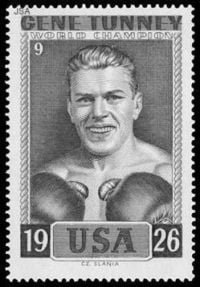Gene Tunney
| Gene Tunney | |
 | |
| Statistics | |
|---|---|
| Real name | James Joseph Tunney |
| Nickname | The Fighting Marine |
| Rated at | Heavyweight |
| Nationality | |
| Birth date | May 25, 1897 |
| Birth place | New York City |
| Death date | November 7, 1978 (aged 81) |
| Stance | Orthodox |
| Boxing record | |
| Total fights | 88 |
| Wins | 82 |
| Wins by KO | 48 |
| Losses | 1 |
| Draws | 3 |
| No contests | 2 |
James Joseph "Gene" Tunney (May 25, 1897 – November 7, 1978) was the heavyweight boxing champion from 1926-28 who defeated Jack Dempsey twice, first in 1926 and then in 1927. Tunney's successful title defense against Dempsey is one of the most famous bouts in boxing history and is known as The Long Count Fight. Tunney retired as a heavyweight after his victory over Tom Heeney in 1928.
Tunney, who in World War I served in the U.S. Marines, had only one loss in his entire professional career — a 15 round unanimous decision to Harry Greb for the American Light Heavyweight title, a defeat that he later avenged in four more fights against Greb. He was regarded as an extremely skillful boxer who excelled in defense.
In addition to beating Dempsey, the most famous fighter of his era, Tunney defeated Tommy Loughran, Tommy Gibbons, Georges Carpentier, and many other fine boxers.
Tunney also had a brief acting career, starring in the movie The Fighting Marine in 1926. Unfortunately, no prints of this film are known to exist.
He was elected as Ring Magazine's first-ever Fighter of the Year in 1928 and later elected to the World Boxing Hall of Fame in 1980, the International Boxing Hall of Fame in 1990, and the Marine Corps Sports Hall of Fame in 2001.
Tunney was of Irish descent, where the Tunney name is still alive. Gene Tunney was the father of John V. Tunney, who was a Senator and Representative from California from 1965 until 1977.
Upon his death in 1978, aged 81, Tunney was interred in the Long Ridge Union Cemetery in Stamford, Connecticut.
Fighting Style
Tunney was a thinking fighter who prefered to make a boxing match into a game of chess which was not popular during the times when such sluggers like Jack Dempsey, Harry Greb and Mickey Walker were commanding center stage. Tunney style was influnced by other noted boxing thinkers such as James J Corbett and Benny Leonard. Always moving and boxing behind a good solid left Jab, Tunney would start reading and disecting his opponent from the first bell, prefering to stay on the outside and nullifying any attack his opponent has at him, he would use quick counters to keep them off balance. Not known as a big puncher Tunney could hit with venom if need be, especially once he had figured his opponent out and they were exhausted or hurt.
Cultural references
Dean Martin and Jerry Lewis had a comedy routine in which Lewis (in boxing shorts and gear) states he's fight'n Gene Tierney (the actress). Martin corrects Lewis and suggests that he must mean "Gene Tunney." Lewis then quips, "You fight who you wanna fight, I'm fight'n who I wanna fight, I'm fight'n Gene Tierney."
See also
- List of heavyweight boxing champions
- International Boxing Hall of Fame
- Ring Magazine fighters of the year
- List of undisputed boxing champions
- Boxing in the 1920s
- List of male boxers
Notes
ReferencesISBN links support NWE through referral fees
External links
- Review of 2006 Gene Tunney biography Retrieved December 11, 2007.
- Template:Boxrec Retrieved December 11, 2007.
- Gene Tunney biography at the Find a Grave site Retrieved December 11, 2007.
- Gene Tunney vs. Jack Dempsey (second match) Retrieved December 11, 2007.
| Preceded by: Jack Dempsey |
Heavyweight boxing champion 1926–1928 |
Succeeded by: Max Schmeling |
Credits
New World Encyclopedia writers and editors rewrote and completed the Wikipedia article in accordance with New World Encyclopedia standards. This article abides by terms of the Creative Commons CC-by-sa 3.0 License (CC-by-sa), which may be used and disseminated with proper attribution. Credit is due under the terms of this license that can reference both the New World Encyclopedia contributors and the selfless volunteer contributors of the Wikimedia Foundation. To cite this article click here for a list of acceptable citing formats.The history of earlier contributions by wikipedians is accessible to researchers here:
The history of this article since it was imported to New World Encyclopedia:
Note: Some restrictions may apply to use of individual images which are separately licensed.

